Making goat milk soap like Grandma did connects you to ancient traditions while creating a product that's gentler on your skin than commercial options. The natural ingredients—raw goat milk, olive oil, and healing herbs—preserve moisturizing glycerin that commercial processing removes. You'll benefit from alpha hydroxy acids, vitamins A and D, and a balanced pH that soothes sensitive skin conditions. Beyond the skincare advantages, you'll experience the satisfaction of crafting something meaningful that spans generations.
The Forgotten Art of Natural Soap Crafting
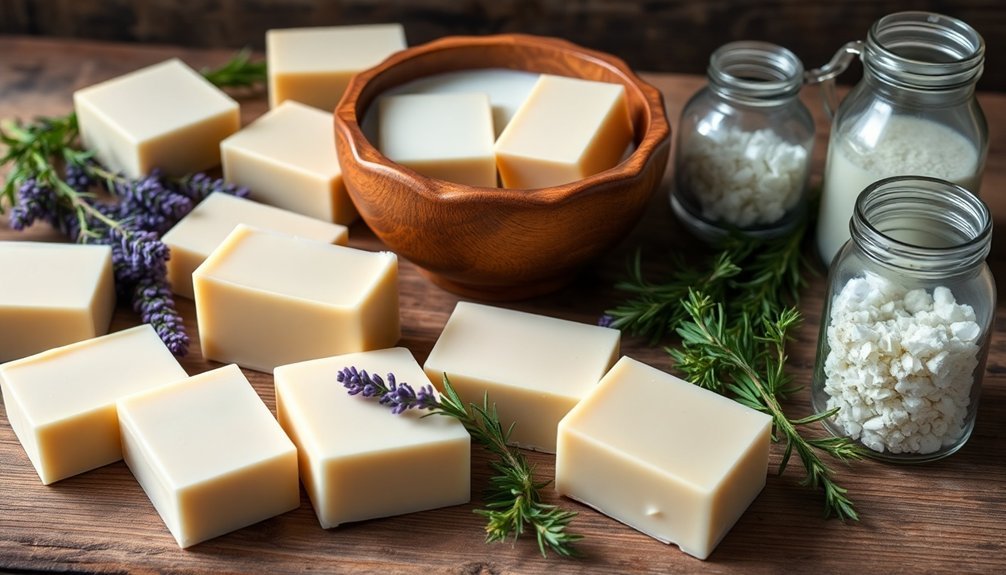
While modern consumers often reach for mass-produced bath products without a second thought, the ancient practice of natural soap crafting tells a richer story of human ingenuity and resourcefulness. This tradition dates back thousands of years, with civilizations around the world developing techniques using local ingredients like goat milk.
When you craft soap by hand, you're participating in a historical skill that's been passed down through generations. The methods have evolved, but the core principles remain unchanged: natural ingredients create gentler, more nourishing products for your skin. Unlike commercial soaps that often lack natural glycerin and contain synthetic detergents, homemade soap retains all of its naturally moisturizing components.
Many traditional recipes highlight goat milk specifically for its exceptional moisturizing properties.
Grandmother's Secret Soap Ingredients Revealed
Your grandmother's simple healing formula included raw goat milk, olive oil, and carefully selected herbs that worked in harmony to nourish damaged skin.
You'll find traditional combinations of coconut oil and shea butter created the perfect balance of cleansing power and moisturizing benefits. The soap provides gentle cleansing without stripping away your skin's natural protective oils.
The timeless addition of calendula petals, lavender buds, and rosemary not only enhanced the soap's healing properties but also infused each bar with natural fragrance.
Simple Natural Healing Formula
Deep within family recipe books, passed down through generations, lies a simple yet powerful goat milk soap formula that grandmothers once cherished for its remarkable healing properties.
This ancestral recipe harnesses the natural power of raw goat milk, rich in over 50 nutrients including vitamins A, B, C, and D that nourish your skin at a cellular level. Just as ancient civilizations embraced goat milk for its exceptional skincare benefits, these traditional recipes preserve this timeless wisdom.
You'll discover the same healing benefits your grandmother relied on:
- Soothing Relief – Natural anti-inflammatory compounds calm irritated skin conditions like eczema, psoriasis, and rosacea.
- Gentle Renewal – Alpha-hydroxy acids and lactic acid gently exfoliate without harsh chemicals.
- Protective Balance – pH-balanced formula maintains your skin's natural barrier while caprylic acid provides antimicrobial protection.
Unlike commercial alternatives, this traditional cold-process method preserves all the skin-nourishing nutrients grandmother trusted.
Traditional Ingredient Combinations
The treasured soap recipes our grandmothers safeguarded weren't just simple mixtures—they were carefully balanced formulations refined through generations of trial and error.
You'll find their core formula typically combined olive oil for moisture, coconut oil for lather, and either palm oil or butters for stability.
What made grandmother's soaps truly special was the addition of nutrient-rich goat milk, which introduced caprylic acid and selenium to gently cleanse while maintaining skin's natural oils.
For therapeutic benefits, they incorporated unrefined shea butter and vitamin A-rich ingredients to combat aging and dryness. Traditional recipes called for freezing milk the night before to prevent the fat from burning when combined with lye.
These elements worked together synergistically—each serving a specific purpose in the final bar.
Their wisdom taught us that proper soap isn't about fancy additives but rather the perfect harmony of simple, quality ingredients.
Timeless Botanical Additions
Long before synthetic additives dominated commercial soaps, grandmother's cherished formulas incorporated botanical elements that served both functional and therapeutic purposes.
You'll find these time-tested additions brought natural benefits that modern products struggle to replicate. Lavender soothed sensitive skin, while oatmeal gently exfoliated dead cells. Calendula and chamomile reduced inflammation for irritated complexions. Raw goat milk provides critical vitamins and nutrients that help restore even the most damaged skin conditions naturally.
- Healing combinations – Feel the relief as lavender and oatmeal work together to calm irritation while eliminating rough patches on your most sensitive areas.
- Aromatic therapy – Experience the uplifting sensation of citrus oils that transform your morning shower into a rejuvenating ritual.
- Protective elements – Trust in nature's shield as thyme and tea tree naturally combat bacteria without harsh chemicals.
Health Benefits Your Skin Will Thank You For
Five remarkable benefits await your skin when you choose goat milk soap over conventional alternatives.
First, the alpha hydroxy acids naturally exfoliate dead cells, revealing fresher skin beneath.
Second, goat milk's pH closely matches your skin, reducing irritation while maintaining your protective barrier.
You'll appreciate how the fatty acids and natural humectants lock in moisture, combating dryness and fine lines.
The vitamins A, D, and B6 work together to repair damaged skin and promote cell regeneration, helping you maintain a youthful appearance.
Those with sensitive skin conditions like eczema or psoriasis will find relief in goat milk soap's anti-inflammatory properties. The natural composition helps create a less processed alternative to chemical-heavy commercial products.
Unlike harsh commercial soaps that strip away beneficial oils, goat milk cleans gently while nourishing your skin's microbiome.
Connecting With Heritage Through Soap Making
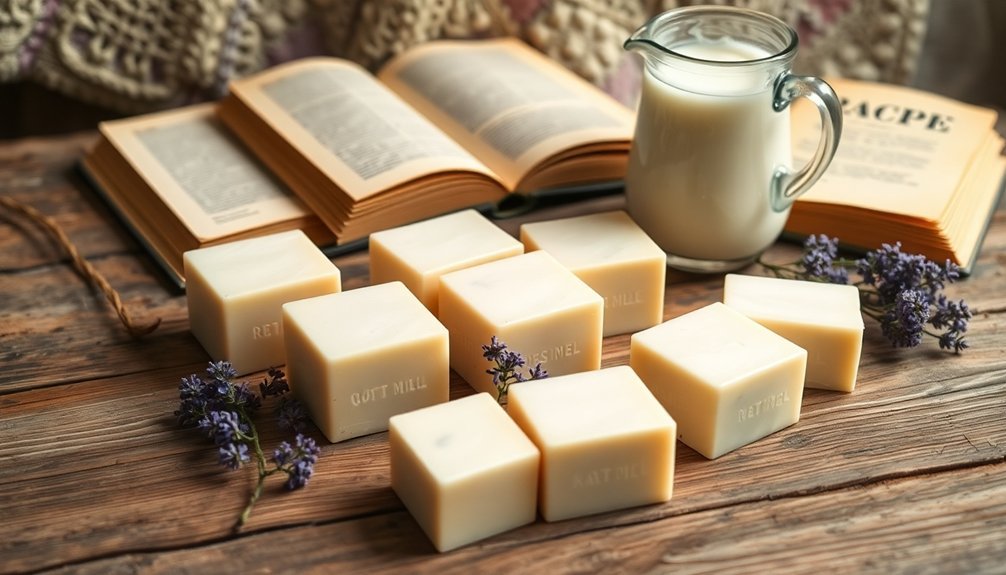
Through centuries of tradition and family heritage, soap making has connected generations in a timeless craft that transcends mere utility.
When you mix your goat milk soap, you're dipping your hands into the same rhythms your ancestors followed, using techniques they perfected through necessity and ingenuity. The chemical reaction called saponification transforms your ingredients into something entirely new, just as it did for those who came before you.
- Reviving ancestral wisdom – Feel the profound connection as you work with recipes your grandmother once carefully measured out in her kitchen.
- Preserving cultural identity – Experience the quiet pride of maintaining regional traditions that might otherwise fade into history.
- Creating tangible heritage – Watch as your children learn alongside you, absorbing not just a skill but a piece of their family story they'll carry forward.
You're not just making soap—you're continuing a conversation across time.
The Chemistry Behind Traditional Goat Milk Soap
When you mix your carefully prepared fats with lye and goat milk, you're initiating saponification—the chemical transformation that creates soap while producing beneficial glycerin as a byproduct.
The process requires precise measurements, as each oil has a unique saponification value determining exactly how much lye is needed for complete conversion without excess harshness. Proper ingredient balance ensures that fatty acids from oils and fats form the primary building blocks of your soap.
Your finished goat milk soap naturally maintains a pH balance that complements your skin's acid mantle, typically falling between 8-10 on the pH scale after proper curing.
Saponification Magic Explained
The transformation of ordinary ingredients into luxurious goat milk soap relies on a fascinating chemical dance called saponification. This exothermic reaction occurs when lye (sodium hydroxide) combines with the fatty acids in your oils and goat milk, creating soap molecules and releasing glycerin as a beneficial byproduct.
When you freeze your goat milk before adding lye, you're preventing scorching and preserving those skin-loving nutrients. The careful balance of temperatures guarantees the rich vitamins and fatty acids remain intact throughout the process. Using at least one ounce of goat milk per full bar ensures the perfect balance of moisturizing properties while maintaining the soap's longevity.
Your handcrafted soap benefits from:
- A perfectly balanced pH that's gentle on even sensitive skin
- Natural glycerin that commercial soaps typically remove
- The complete transformation of harsh lye into a nourishing product your grandmother would recognize
Ph Balancing Act
Despite common marketing claims, the pH balancing act of goat milk soap isn't quite what you might expect.
While goat milk has a pH of 6-6.5 (closer to skin's natural 5-6 pH), the finished soap remains alkaline at 9-10 due to the lye required for saponification.
Your skin's acid mantle will temporarily shift after using any soap but naturally restores itself within hours. The acid mantle typically replenishes within 2-3 hours after washing.
The real benefits of goat milk soap come not from its pH, but from its rich composition of vitamins, minerals, and fatty acids that moisturize your skin.
The unsaponified fats in goat milk provide gentler cleansing than synthetic alternatives.
When making traditional goat milk soap, you're creating a product that nourishes skin through its natural ingredients rather than achieving some mythical "perfect pH balance."
Essential Tools for Old-Fashioned Soap Creation
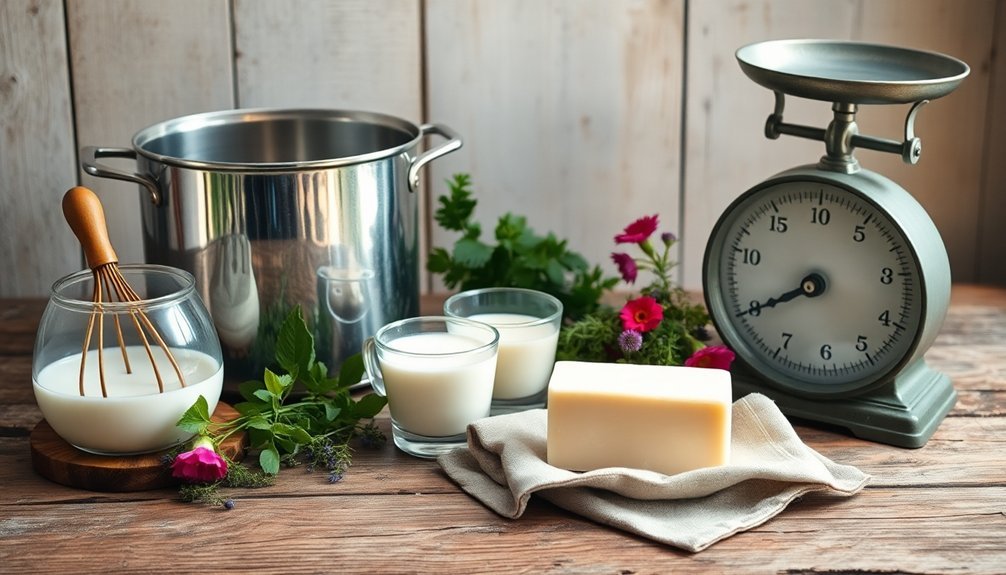
Crafting traditional goat milk soap requires specific tools that guarantee both safety and quality in your final product.
The artisan's journey into soap craft begins with proper tools—the gatekeepers of both safety and excellence.
You'll need protective gear including goggles and elbow-length rubber gloves to shield yourself from caustic lye. Non-reactive equipment such as stainless steel bowls and silicone spatulas prevent unwanted chemical reactions during the mixing process. It's crucial to keep your soapmaking equipment completely separate from any items used for food preparation.
- Digital scales – Precise measurements make the difference between harsh, unusable soap and grandmother's silky-smooth treasures.
- Thermometer – Feel the satisfaction of hitting that perfect temperature sweet spot where oils and lye unite in soapy harmony.
- Wooden or silicone molds – Experience the anticipation as you pour your creation into these vessels, knowing each unmolding reveals your artisanal achievement.
Step-by-Step Traditional Cold Process Method
Five distinct phases mark the traditional cold process method of goat milk soap making, each requiring patience and precision. You'll start by freezing your goat milk to prevent scorching when lye is added. Next, carefully combine the lye with your frozen milk, stirring until completely dissolved.
While that mixture cools, melt and blend your oils to 90-100°F. When both mixtures reach similar temperatures, combine them and blend until reaching "trace" – the point where the soap begins to thicken. Using high-quality oils will result in soap with better conditioning properties. Pour your creation into molds and let nature do the rest.
| Phase | Action | Time |
|---|---|---|
| Preparation | Freeze milk | Overnight |
| Lye Solution | Mix lye with frozen milk | 10-15 min |
| Oil Blending | Melt and combine oils | 20 min |
Seasonal Herbs and Scents for Your Homemade Bars
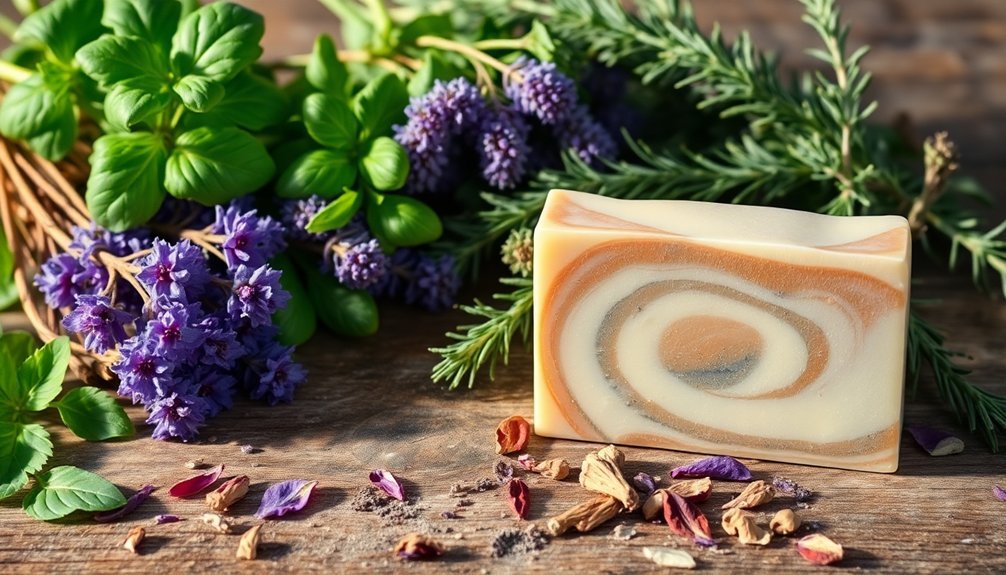
The seasonal calendar offers four distinct opportunities to enhance your goat milk soap with nature's aromatherapy.
Spring's lavender and chamomile give way to summer's invigorating mint and basil, while autumn brings earthy sage and marigold.
Even winter offers pine and spruce scents, with calendula remaining versatile year-round. The Flowering Herbs variety combines blooming garden flowers with herbs for a fresh, clean scent.
You'll find multiple ways to infuse these natural fragrances—from heated olive oil infusions to steeping herbs like tea.
The lactic acid in goat milk works perfectly with these botanicals, creating bars that gently exfoliate while delivering nature's vitamins to your skin.
- Memory triggers – Seasonal scents connect your soap to cherished holiday memories
- Mood lifters – Spring florals can brighten moods during dreary days
- Gift appeal – Seasonal-themed soap makes thoughtful, personalized presents
Troubleshooting Common Issues in Handmade Soap
While seasonal herbs add delightful scents to your soaps, even experienced soap makers encounter challenges along the way.
You'll likely face issues with texture—soaps that are too soft, sticky, or brittle—usually from incorrect water amounts or insufficient curing time. High humidity environments can significantly delay the hardening process, so consider using a dehumidifier if needed.
If your beautiful goat milk soap develops discoloration or soda ash (that white powder on the surface), don't worry.
These common problems stem from fragrance oils, oxidation, or air exposure. For scent fading, store your bars in cool, dry places and consider using higher concentrations of essential oils.
When separation occurs, check your mixing temperature and technique.
Re-mixing or heat processing can often salvage your batch.
Remember, adding ingredients like beeswax improves hardness, while honey enhances moisturizing properties.
With each troubleshooting experience, you'll develop greater skill—just like grandma did.
Storing and Curing Your Soap the Traditional Way

Once your goat milk soap has been poured into molds, proper curing becomes essential for creating the perfect bar.
You'll need to allow 4-6 weeks of curing time to achieve maximum mildness and hardness. After the initial 48 hours, your soap will be safe to touch but not ready to use.
Store your soap with space between bars in a well-ventilated area away from direct sunlight, and remember to flip them regularly for even drying.
- Feel the satisfaction of watching your soap bars gradually harden and develop that characteristic glow that only properly cured traditional soap achieves
- Experience the pride of following time-honored methods that guarantee your soap reaches its ideal quality without rushing the process
- Enjoy the anticipation of unwrapping your first fully-cured bar, knowing you've created something truly special with your own hands
Modern Twists on Grandma's Classic Recipes
Modern soap makers have revolutionized traditional goat milk soap recipes, blending time-honored wisdom with contemporary innovations.
The art of goat milk soap-making marries ancestral techniques with modern ingenuity, transforming humble ingredients into luxurious cleansing bars.
You'll find numerous customization options using essential oils and unique fragrances that weren't available to your grandmother.
The cold process method reduces milk scorching risks while digital thermometers and immersion blenders simplify the entire process.
For sensitive skin, try superfatting your soap or adding gentle ingredients like oatmeal and raw honey.
Get creative with silicone molds to craft unique shapes beyond the traditional rectangular bars.
Add visual appeal with natural colorants like turmeric or coffee, or create stunning swirled patterns using multiple colors.
Consider layering techniques and decorative toppings like dried herbs or flowers to transform grandma's practical soap into an artisanal masterpiece that's both functional and beautiful.
Properly stored goat milk soap can maintain its quality and beneficial properties for shelf life of approximately six months to a year when kept in a cool, dry place.
Sharing Your Handcrafted Soap as Meaningful Gifts
You'll create memorable impressions when you package your handcrafted goat milk soaps in personalized care bundles tailored to each recipient's skin needs and preferences.
Wrap your soap gifts in materials that tell a story, such as upcycled fabric scraps from family heirlooms or handmade paper embedded with wildflower seeds.
These thoughtful touches transform your soaps from simple presents into meaningful expressions of care that connect your craft to cherished traditions. Handmade soaps offer a special gift experience that elevates everyday routines into pampering rituals that recipients will treasure.
Personalized Care Packages
Sharing your handcrafted goat milk soap as part of personalized care packages transforms simple bars into meaningful expressions of thoughtfulness.
When you create custom gift sets that include your soaps alongside complementary items like bath bombs, lotions, and soy candles, you're offering a complete self-care experience tailored to the recipient's preferences and skin needs.
These personalized packages create deeper connections than store-bought alternatives because:
- Natural nourishment – Your chemical-free goat milk soap delivers moisturizing benefits that commercial products can't match.
- Thoughtful customization – Selecting scents and ingredients specifically for someone shows you truly understand their needs.
- Celebratory intention – Themed packages for special occasions like birthdays or baby showers demonstrate your care through purposeful curation.
Consider starting your gifting journey with handmade soap gift boxes available from CA$50.00 that can be fully customized to match your recipient's preferences.
Heritage Gift Wrapping
Heritage gift wrapping elevates your handcrafted goat milk soap from a thoughtful item to a cultural treasure. When you wrap your soap in traditional fabrics like Korean bojagi or Japanese furoshiki, you're not just presenting a gift—you're sharing your heritage.
Consider wrapping your soaps in batik fabrics with their distinctive wax-resist patterns, or use vibrant African kente cloth for special occasions. Each wrapping style tells a story and honors craftsmanship across generations. The fabric choice itself communicates the occasion's significance and your attention to detail. Japanese Furoshiki techniques emphasize resourcefulness and sustainability through their elegant reusable nature.
Beyond aesthetics, these fabric-wrapping techniques offer sustainability benefits that complement your handmade soap's natural qualities. The recipient receives two gifts: your carefully crafted soap and a beautiful, reusable wrapping that continues to serve long after the soap has dissolved.
Frequently Asked Questions
Can Goat Milk Soap Help With Specific Skin Conditions Like Eczema?
Yes, goat milk soap can help with eczema. Its moisturizing properties, natural pH balance, and anti-inflammatory ingredients soothe your irritated skin. You'll find its gentle exfoliation and lack of harsh chemicals particularly beneficial.
How Long Does Handmade Goat Milk Soap Typically Last?
Your handmade goat milk soap typically lasts 1-3 years when stored properly. You'll get the most longevity by keeping it in cool, dry places away from sunlight, allowing it to dry between uses.
Is Goat Milk Soap Safe for Infants and Young Children?
Yes, goat milk soap is safe for your little ones. It's hypoallergenic, gentle on sensitive skin, and contains natural nutrients. You'll want to choose unscented versions and always do a patch test first.
Can I Substitute Other Animal Milks in Traditional Recipes?
Yes, you can substitute other animal milks like cow's, sheep's, or buffalo milk in traditional recipes. You'll need to adjust lye calculations and temperature control techniques to accommodate each milk's unique fat content.
How Does Seasonal Variation in Goat Milk Affect Soap Quality?
Seasonal changes in goat feed affect milk fat content, altering your soap's moisturizing properties and lather. You'll need to adjust your recipe throughout the year to maintain consistent quality in your handmade soaps.
In Summary
You've rediscovered something precious – a traditional craft that nourishes both skin and soul. As you continue making goat milk soap, you're not just creating a superior product; you're preserving family wisdom and connecting with generations past. Don't keep this joy to yourself! Share your creations and knowledge with loved ones. After all, grandma's wisdom wasn't meant to be forgotten, but passed down and celebrated.

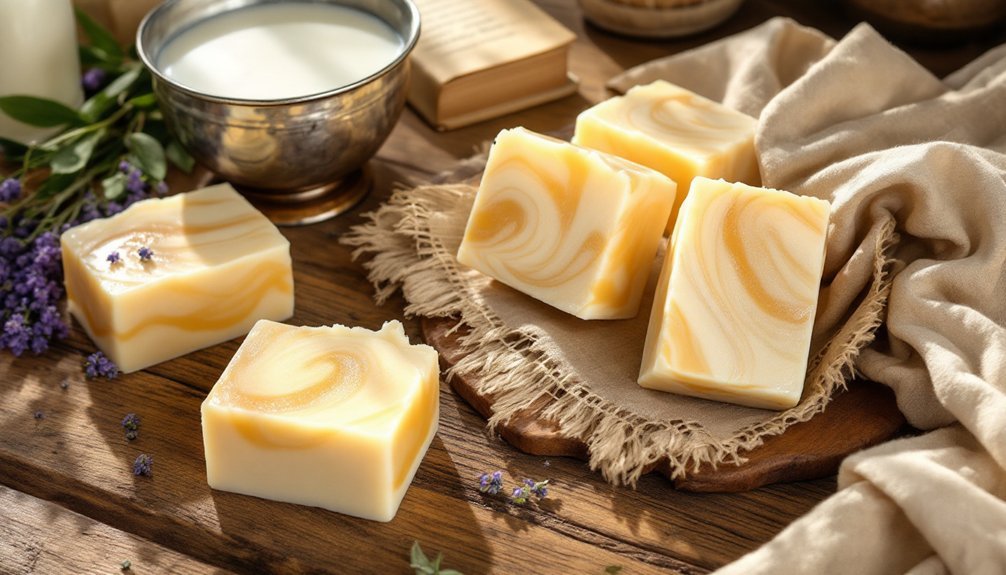



Leave a Reply